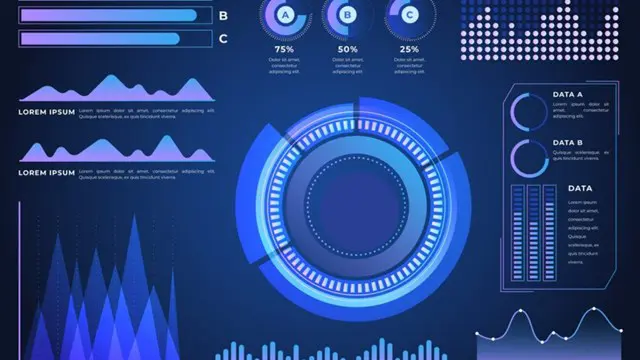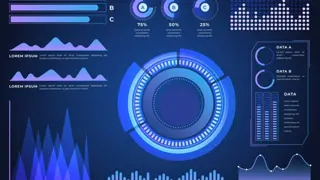
Bundle Course - SAP BO and SAP Data Services (BODS)
Self-paced videos, Lifetime access, Study material, Certification prep, Technical support, Course Completion Certificate
Uplatz
Summary
- Certificate of completion - Free
- Reed courses certificate of completion - Free
Add to basket or enquire
Overview
Uplatz offers this comprehensive bundle course on SAP BO and SAP Data Services (BODS) consisting of a combo of video courses on all topics that are associated with SAP BusinessObjects Business Intelligence and SAP Data Services (BODS). You will be awarded Course Completion Certificate at the end of the course.
SAP Business Objects (BO) is a centralized suite of reporting and analytics tools for business intelligence (BI) platforms. SAP Business objects BI uses drag and drop functions and allows users to search and analyze data from a wide variety of sources.
The core of SAP BO is the SAP Business objects universe, which are layers of metadata that integrate the back-end data with the front-end application layer. SAP BO workflow is defined as a collection of methods or events for an entity in business process.
The SAP Business Objects platform is the core of the reporting and analysis suite. The platform is used as primary access to publish, store, create and share reports and to perform analysis within the different products.
SAP BO Data Services (BODS) is an ETL tool used for data integration, data quality, data profiling and data processing. BO Data Services consists of a UI development interface, metadata repository, data connectivity to source and target system and management console for scheduling of jobs.
SAP BODS combines industry data quality into one platform. BODS provides a single environment for development, run-time, management, security, and data connectivity.
Keys of skills and responsibilities
- Back end databases will be sql server, My sql and need to consolidate it in SAP BW
- Clarity on ETL Concepts
- Experience of using BO DS for target Database as BW
- Excellent communication and interpersonal skill for client communication
- Understanding of the technical business and organizational requirements of a performance management, data warehouse or business intelligence project.
- Strong data modelling, data warehouse design experience to design and maintain universes.
Uplatz provides this extensive training on SAP BO and SAP BODS covering all relevant modules in a bundle course.
Curriculum
Course media
Description
Bundle course - SAP BO BUSINESS OBJECTS and SAP BODS – COURSE SYLLABUS
SAP BusinessObjects (BO) Business Intelligence is a reporting tool offered by SAP. SAP BO offers intelligent solutions that can be made use of by people ranging from analysts and other people who work with information to CEO’s.
- Introduction:
- Understanding BusinessObjects Enterprise
- What is BusinessObjects Enterprise?
- Working with SAP BO Launchpad (Infoview)
- SAP Business Objects Web Intelligence and BI Launch Pad 4.1
- SAP Business Objects Dashboards 4.1
- BI launch pad: What’s new in 4.1
- Restricting data returned by a query
- Enhancing the presentation of data in reports
- Formatting reports
- Calculating data with formulas and variables
- Using multiple data sources
- Analyzing data
- Managing and sharing Interactive Analysis documents
- Reporting from Other Data Sources
- Introducing Web Intelligence
- Accessing corporate information with Web Intelligence
- Understanding how universes allow you to query databases using everyday business terms.
- Managing documents in InfoView
- Viewing a Web Intelligence document in InfoView
- Setting Info View Preferences
- Creating Web Intelligence Documents with Queries
- Getting new data with Web Intelligence
- Creating a new Web Intelligence document
- Modifying a document’s query
- Working with query properties
- Restricting Data Returned by a Query
- Modifying a query with a predefined query filter
- Applying a single-value query filter
- Using prompts to restrict data
- Using complex filters
- Displaying data in tables and charts
- Presenting data in free-standing cells
- Enhancing the Presentation of Reports
- Using breaks, calculations, sorts and report filters
- Ranking data to see top or bottom values
- Using alerter to highlight information
- Organizing a report into sections
- Copying data to other applications
- Alternative Query Techniques Using Combined Queries Using Sub-Queries
- Creating a Query based on another Query
- Character and Date String Functions Using the character string functions Concatenating different data types Using date functions
- Using If Logic
- Grouping data using If() logic
- Using If() to modify calculation behaviour
- Advanced Reporting Features Formatting breaks
- Creating custom sorts
- Displaying document data in free-standing cells
- Alternative Query Techniques Defining Combined Query Types Using Combined Queries
- Using Sub-Queries
- Creating a Query on a Query
- Character and Date String Functions Understanding Character Strings
- Using Date Functions User-Defined Objects Creating User Objects
- Using a User Object in a Query
- Editing a User Object Deleting a User Object Storing a User Object Grouping Data
- Information Design Tool 4.0
- What is the Information Design Tool (IDT)
- Create a project
- Create a connection to a relational database (Single and Multiple databases)
- Create the data foundation with Single & Multiple databases
- Define the different types joins in a data foundation
- Create a business layer
- Create folders and objects
- Resolve Loops and Use alias
- Resolve Loops Use contexts
- Resolving the fan traps and Chasm traps problem
- Define data restrictions
- Work with LOVs
- Use Parameters restrict data
- Use @functions also Aggregate Awareness
- Create Derived Tables and Index Awareness
- Maintain universes
- Deploy and manage and maintain universes
- Universe Designer Tool 4.0
- Understanding Business-Objects Universes.
- Understanding how universes allow users to query databases using their everyday business terms.
- Creating Universe Connections.
- The course database and universe.
- Creating the universe.
- Building and populating the Universe Structure.
- Defining joins in a universe.
- Creating Dimension Objects.
- Understanding classes and objects.
- Creating Measure Objects.
- Understanding measure objects.
- Using List of Values.
- Resolving Loops.
- Resolving loops using aliases.
- Resolving loops using contexts.
- Chasm traps and Fan traps.
- Restricting the data returned by objects.
- Using Functions with Objects.
- Using @ Functions.
- Using Hierarchies.
- Working with hierarchies.
- Aggregate Awareness.
- Derived Tables
- Securing Universes.
- Managing Universes
- SAP Business Objects Dashboards 4.0 (Crystal Xcelsius 2011)
- Crystal Xcelsius Overview
- Creating Dashboards using Query As A Web Service (QAAWS) and Live Office
- Create Drill Down dashboard reports
- What’s new in SAP Business Objects Dashboards 4.0
- Creating a Visualization
- Producing interactive visualizations
- Getting around in Xcelsius
- Working with your Excel workbook
- Visualizing data with charts
- Using Xcelsius Components
- Formatting a Visualization
- Applying formatting options
- Using themes and templates to apply formatting
- Adding Interactivity to a Visualization
- Using selectors
- Adding dynamic visibility
- Using live data sources
- Connecting to BO Universes using Query as a Web Service
- Using Live Office data
- Creating Complex dashboards
- SAP Crystal Reports 2011
- Creating reports
- Selecting records
- Organizing data on reports
- Formatting & section formatting
- Creating basic and complex formulas
- Using variables
- Using report templates
- Applying conditional reporting
- Building parameterized and specialized reports
- Summarizing data with cross tabs
- Using report sections
- Representing data visually
- Managing reports
- Distributing reports
- Using repository and repository data sources
- Report processing
- Linking Crystal Reports to Webi reports
- Drill down reports
SAP BODS COURSE SYLLABUS
Data Services – Advance Level
- BODS Admin Console – Administration, Auto Reporting
- Real time Jobs, Embedded Data Flows & Security
- Variables, Parameters, Substitution Parameters, System Config
- Debugging, Recovery Mechanism
- Data Assessment – Data Profiling
- BODS Performance Tuning Techniques
- Multi-User Development Environment – Into & Advantages
- Multi-User Environment – Implementation & Migration
Session : 2 – Data Services – SAP Extraction Introduction
- SAP Systems – Into, SAP Systems allowed, Terminology
- SAP BODS and SAP ERP / SAP BI Integration
- SAP BODS User & Role creation in SAP
Session : 3 – Data Services – SAP ERP Extraction
- SAP ERP – Data Flow, Interfaces, and Objects allowed to BODS
- Creating SAP Application Datastore – Properties
- SAP ERP – Tables & Hierarchies Data Extraction
- SAP ERP – Getting RFC enabled Functions Modules
- SAP ERP – IDOC Data Extraction & IDOC Data Loading
- SAP ERP – Extracting Flat file data from SAP APP Server
Session : 4 – Data Services – SAP BW/BI Extraction & Loading
- SAP BW – Data Flow, Interfaces, and Objects allowed to BODS
- Creating SAP BW Source & SAP BW Target Datastores
- SAP BW – Extracting Data from SAP BW InfoProviders – OHD
- SAP BW – Extracting Data from SAP BW bases tables – /BIC/
- SAP BW – Loading data to SAP BW InfoProviders (MD & TD)
- SAP BW – BW Jobs Execution
Session : 5 – Data Services – SAP Advanced Concepts
- SAP BusinessObjects Rapid Marts – Introduction & Overview and differences between 3.x and 4.x
- SAP BusinessObjects Extractors Extraction – Introduction of ODP, SAP DataSources Extraction, SAP Delta Mechanism and DOP Queue
- SAP Data Migration with BODS – Data Migration Techniques, BODS Data Migration to SAP, Data Migration Tool Introduction and Overview
Who is this course for?
Everyone
Requirements
Passion and determination to achieve your goals!
Career path
- SAP BO Consultant
- SAP BODS Consultant
- SAP Data Services Consultant
- Data Consultant / Manager
- Data Engineer
- Data Analyst
- Data Engineer
- Reporting Analyst
- ETL Developer
- BO Developer
- Developer Consultant
- System Administrator
- System Architect
- Technology Consultant
Questions and answers
Currently there are no Q&As for this course. Be the first to ask a question.
Certificates
Certificate of completion
Digital certificate - Included
Course Completion Certificate by Uplatz
Reed courses certificate of completion
Digital certificate - Included
Will be downloadable when all lectures have been completed
Reviews
Currently there are no reviews for this course. Be the first to leave a review.
Legal information
This course is advertised on reed.co.uk by the Course Provider, whose terms and conditions apply. Purchases are made directly from the Course Provider, and as such, content and materials are supplied by the Course Provider directly. Reed is acting as agent and not reseller in relation to this course. Reed's only responsibility is to facilitate your payment for the course. It is your responsibility to review and agree to the Course Provider's terms and conditions and satisfy yourself as to the suitability of the course you intend to purchase. Reed will not have any responsibility for the content of the course and/or associated materials.


